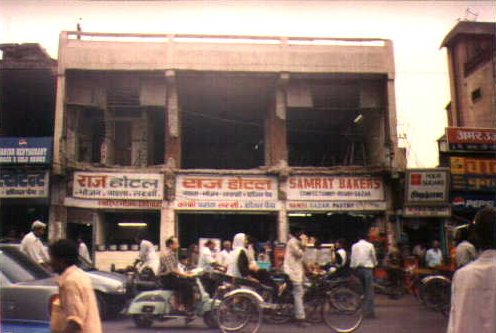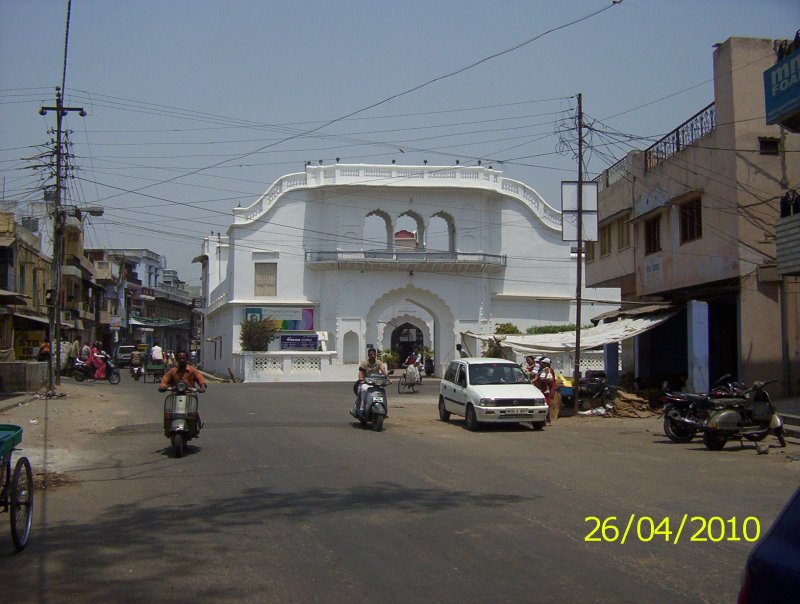Augarnath Mandir, Colonial Bungalow, Old Indian Houses, Meerut, INDIA - 4
May not look right in Netscape and AOL Browsers. Press F11 for a better view.
Here is something great - tell us where you came from:May not look right in Netscape and AOL Browsers. Press F11 for a better view.
Here is something great - tell us where you came from:
The Beautiful temple complex, close to the old Augarnath ka mandir. Here the people who fired the 1st shots of the 1857 Meerut mutiny, planned their operations.
Here is something written in 1880. Some of the really involved British of the Raj era probably understood us better than we did ourselves.
Page 2 "INDUSTRIAL ARTS OF INDIA" by George C.M. Birdwood, C.S.I, M.D. EDIN., Art reference for the Indian section of the South Kensington Museum First Edition 1880
The intimate absorption of Hindu life in the unseen realities of man's spiritual consciousness is seldom sufficiently acknowledged by Europeans, and indeed cannot be fully comprehended by men whose belief in the supernatural has been destroyed by the prevailing material ideas of modern society. Every thought, word, and deed of the Hindus belongs to the world of the unseen as well as of the seen ; and nothing shews this more strikingly than the traditionary arts of India. Everything that is made is for direct religious use, or has some religious significance. The materials of which different articles are fashioned, their weight, and the colours in which they are painted, are fixed by religious rule. An obscurer symbolism than of material and colour is to be traced also in the forms of things, even for the meanest domestic uses. Every detail of Indian decoration, Aryan, or Turanian, has a religious meaning, and the arts of India will never be rightly understood until there are brought to their study not only the sensibility which can appreciate them at first sight, but a familiar acquaintance with the character and subjects of the religious pontry, national legends, and mythological scriptures that have always been their inspiration, and of which they are the perfected imagery.
And this is more contemporary - William Dalrymple : " Indraprastha had fallen; six hundred years of Muslim domination
had come and gone; a brief interruption by the British was almost
forgotten. But Shiva, the oldest living God in the world, was still
worshipped; Sanskrit - a language which predates any other living
language by millennia - was still read, still spoken. Moreover, the
sadhus and rishis - familiar figures from the Mahabharata- remained
today, still following the rigorous laws of India's most ancient
vocation: giving up everything to wander the face of the earth in
search of enlightenment; renouncing the profane in the hope of a
brief glimpse of the sacred. In these wet and dishevelled figures
sitting cross-legged under the neem and banyan trees of the river
bank lay what must certainly be the most remarkable Delhi survival of
all."
Page 338 The city of Djinns ( A year in Delhi ) : William Dalrymple.
He is wrong about forgetting the British. We retain the "Steel Frame" with great fervour. Unless this is dismantled we are not going anywhere.

Want to know what life in the Bungalows was like for the British.. Click here . An old Bungalow on the Mall Road, almost unmodified. ( Modifications to some very pedestrian British construction is viewed very seriously by authorities. ).That is an issue of some importance in all cantonments. The British left Government in loyal hands. 54 or more years after they left, beautiful new buildings have been destroyed, after quoting verbatim not only pre independence laws, but laws and deeds dating to 1836!, some 20 years before the 1857 Sepoy Mutiny. Yet officially we are very proud of the mutiny, which is also called 'War of Independence', to the extent that a historical monument like the Ajitgarh memorial has been desecrated. Contradictory actions are second nature to the powers that be. Confused and mixed up is our middle name. This faith in outdated laws, restricts itself to those employed by the Government in civil and army jobs. Others senior politicians, professional , self employed people and the ordinary taxpayer * ( those excluded from legacy training procedures ) feel that they are quite obviously the main hindrance to India's economic well being. Unbelievably even repair of dilapidated boundary walls has a tendency to attract severe reprimand by 'officers'. This cantonment was a ruinous area (it still is ) - until all the 'unauthorised' structures came up - some of them very good privately run schools.
There is an enormous resistance to modify outdated laws! These constitute the most dangerous colonial leftover. The people who could suggest changes would be from the bureaucracy. Regrettably such a reverence is built into them for hand me downs ( through their training which is also a hand me down ) that they quake at the very thought. What Macaulay could do on a short visit of two years without even a legitimate post ( he had a vague 'member of the Supreme council for India' designation ) our Babus will not even bring up for consideration. Some of these laws are very correct in a bookish ( like Macaulay ) manner, so correct that they cannot be made to operate effectively. ( What is a cantonment? How did they appear in India? Are they still relevant? Click here for a very well investigated write-up).

It is not obvious that the upper floor is broken. Not by an explosion, or fire, or an earthquake but by people whose salaries are paid by the poor people of India. The upper section was built in 1989, after sustained and repeated efforts to get permission failed. Then suddenly they arrived without warning and destroyed the construction, early in 2001 - 12 years later. If you are looking for any explanations why no innovative ideas start from India, you will find them by investigating such behaviour in depth. Even initiative is penalised. This is the handy work of 3 clowns a DEO (Defence Estates Officer), a CEO (cantonment Executive Officer) and a Fauji (Brigadier). They persist in applying a dead law (CGO 179 also called the old grant of 1836) proclaimed by a long forgotten, long dead ( the CGO stands for Council General Order) and disreputed authority (the East India Company ). For some inexplicable reason this area is in the EIC outlined cantonment. This has always been a bazaar area even before the East India Company ( pre 1803 ) Maybe the EIC draftsman who was outlining the cantonment extent had a little extra dose of opium.
( What is a cantonment? How did they appear in India? Are they still relevant? Click here for a very well investigated write-up.)
The bigger picture shows a behaviour, which cannot be understood using the precepts of common sense.
This is how it looks. In a country where even the Capital seems to be in ruins to people from better looking countries - both eastern and western - we are applying the outdated laws created by an opium selling business organisation of an alien country - to destroy not build.
It is a fact that in the Babu's milieu Commonsense* is regarded with the same disdain reserved normally for an underground barbaric cult. In case you are searching for an English word which roughly means the same thing as Babugiri or "lakeer ke faqir" it is "legalism" which means following the letter of the law rather than the spirit of the law. It is for actions such as these that locals often say that "Yeh kanoon hi gair Kanooni hain" or "the laws themselves are illegal". They must be if they date to the 1830s.
I am certain that all right thinking Indians will agree that a thorough overhaul of regulations relating to Land, Property, construction renovation will electrify the Economy. This harassment is not restricted to 'Defence lands' . It is the same thing in the city. Maybe all over North India.
* When it comes to Government behaviour only one country has an entire structure built on the foundation of Commonsense. You guessed it - the US. The pamphlet which led to the US Declaration of Independence two months later was called COMMON SENSE written by Thomas Paine. Sadly that did not make the US constitution perfect ( or we would not have had a Timothy Mcveigh ), it just makes it better than others. Click here to read. This has more than one page. To come back right click the back arrow on your browser and select the page to return to.
Place cursor on lines below for picture to change.
1. A very large house near Sadar Thana. 2. A smaller one walking distance from the above one.
House 1:A stately and unusual design ,yet a very local one. May have housed a public official. Now has the office and shop of HEEMO computer consumables. Has been with them at least since 1850s. Spacious houses with trees and gardens do not mean celebrity ownership, they may not be the norm they certainly are extremely common. You can walk through narrow galis (lanes) in the old section of the city ( within the gates of Khair Nagar darwaza, Shambu gate, Dilli gate , Shapir gate, Lisari gate etc. ) and enter houses with spacious courtyards, not many gardens though, those are more likely to be in the newer colonies. Like Saket, Defence , Pallavpuram, Shastri Nagar, Ganga Nagar.
House 2: a very liveable design still very common , but disappearing fast .
 Hi ! Do write back with reactions /suggestions /objections...
Hi ! Do write back with reactions /suggestions /objections...

